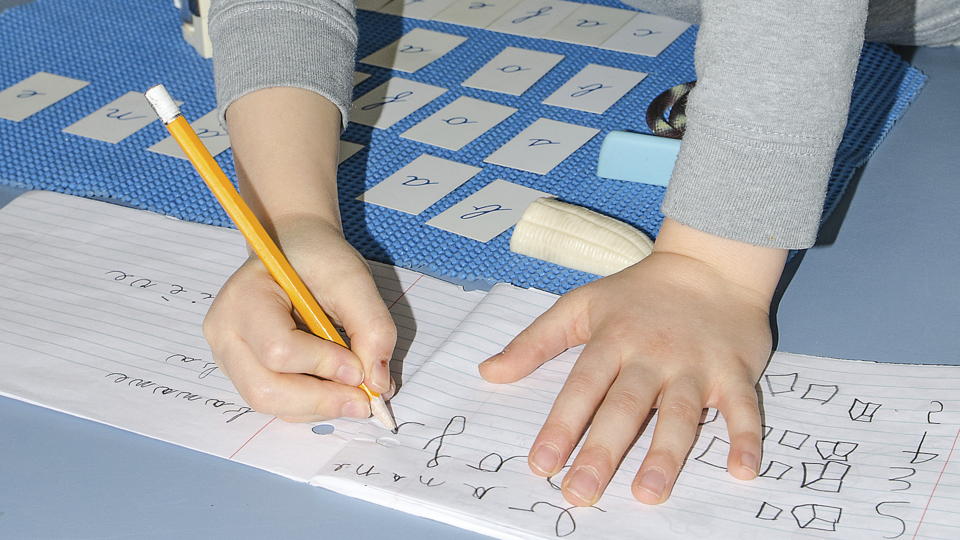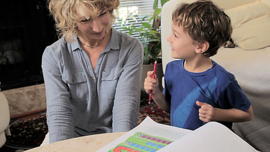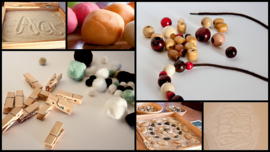Top 4 ways to improve handwriting

Try these teacher tips for building motor skills and coordination kindergarten writers need.
I see a wide a range of skills when students walk through the door in kindergarten. When it comes to small motor development, the range of skills is absolutely huge!
In a typical year, I will have students who are able to write their name, begin writing words to represent their thoughts, cut beautifully, and use wide variety of art supplies. I will also have students who have an improper pencil grip, don’t know how to write the first letter in the name, hold scissors upside down, and are only able to produce a few scribble marks on their paper to represent a picture or words.
There are a variety of reasons for this discrepancy. Outsiders coming into the classroom will often say, “Didn’t their parents do any of these activities with them?” Many times, the parents ARE trying at home, but they may not have materials to work with, a child may not have any interest in drawing or art which can cause frustration for everyone involved, or a child may not have been developmentally ready to master these skills.
Whatever the reason for a child entering kindergarten and struggling with small motor skills, there are a few ways I like to help them when they enter my classroom, and it doesn’t all have to do with holding a pencil.
Learning to write requires so much more than the ability to hold a pencil and form letters properly. It requires fine motor control, visual coordination, strength in the core muscles, well developed hand muscles, and the attention span to focus for a period of time. Without these skills, kids get frustrated and throw in the towel. How do we help them build muscles, strengthen their hands, develop visual coordination, and build stamina to set kids up for success? Here are my top four tips:
Easel drawing or painting
I love having students in my classroom work at the easel. First of all, a reluctant writer will find the easel much more appealing than sitting in their desk. It’s a much more active process, for those kids who have no desire to sit still. As adults, we don’t really think about how much work it is to write. It takes a lot more arm and shoulder strength than we realize. Writing on a vertical surface helps develop those muscles in the arms and shoulders that are needed for writing. I have never had a student pass up a turn on the easel. They love it, and I know it’s really good for their handwriting in the future!
Play dough and clay
It’s probably been a while since you spent a lengthy amount of time handwriting a letter to someone, but if you have, you know that it’s not easy! After the first paragraph you’ll notice the muscles in your hand starting to hurt. Adults have pretty well developed hand muscles, but for kids, this might be all new. I absolutely love having kids play with play dough and clay as part of our developmental centers. Rolling snakes, balls for snowmen, and the simple act of squishing clay to create something, is helping build those small muscles in a child’s hands. By building those muscles, over time kids will be able to write for longer periods of time.
Develop core muscles through play
I’ll never forget the year I had a kindergarten student who absolutely could not sit crisscross on the carpet. After about 30 seconds, he was sprawled out on the floor, saying he just couldn’t sit any more. After talking with our school’s Occupational and Physical Therapist, reviewing the boy’s file, and talking with the parents, we determined that he had such poor trunk strength that it was physically challenging for him to sit upright. This also explained the inability for this little boy to sit at his desk and write. His was a very extreme situation, where he had spent the first 3 years of life in an orphanage in another country, spending much of the day in a crib. It was determined that he just hadn’t had enough opportunity to develop the core muscles needed for everyday things like sitting on the floor or sitting in a chair. After learning about this, I spent quite a bit of time reading research about the correlation between core strength and small motor skills. It was enough to convince me that spending time crawling through tunnels, playing on the monkey bars, climbing tall towers, and playing with the parachute is time well spent. Think about the amount of active, gross motor, play your child is participating in each day and see what you can do to increase that. It may end up helping their small motor control as well.
Learn how to properly hold a pencil
After teaching for 19 years, this is still a skill I struggle teaching to a child. For me, it’s automatic. I pick up a pencil and start writing. There’s no other way, in my mind, to hold a pencil and anything other than the way I do it feels awkward. Kids, on the other hand, always surprise me with their pencils grips. As teachers, we know first hand how an improper pencil grip can slow down a child’s writing. Teaching the proper grip from the start will help enforce positive skills and help keep kids from getting discouraged. The Dynamic Tripod Grip is the method I teach my students. Their thumb should be bent, middle and forefinger should be on the top, and the pencil should be going through the Cheerio or donut that is made by putting fingers together in this way. Depending on the needs of child or the type of correction they need, triangular shaped crayons may help remind a child which fingers to use to hold a crayon. Another strategy is to use small nubs of broken crayons to discourage a whole-hand grasp of the crayon.












